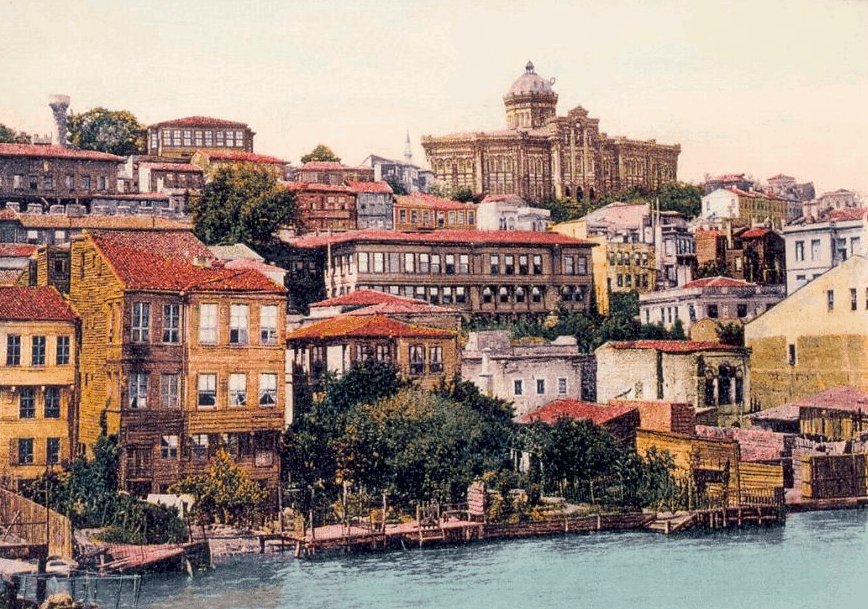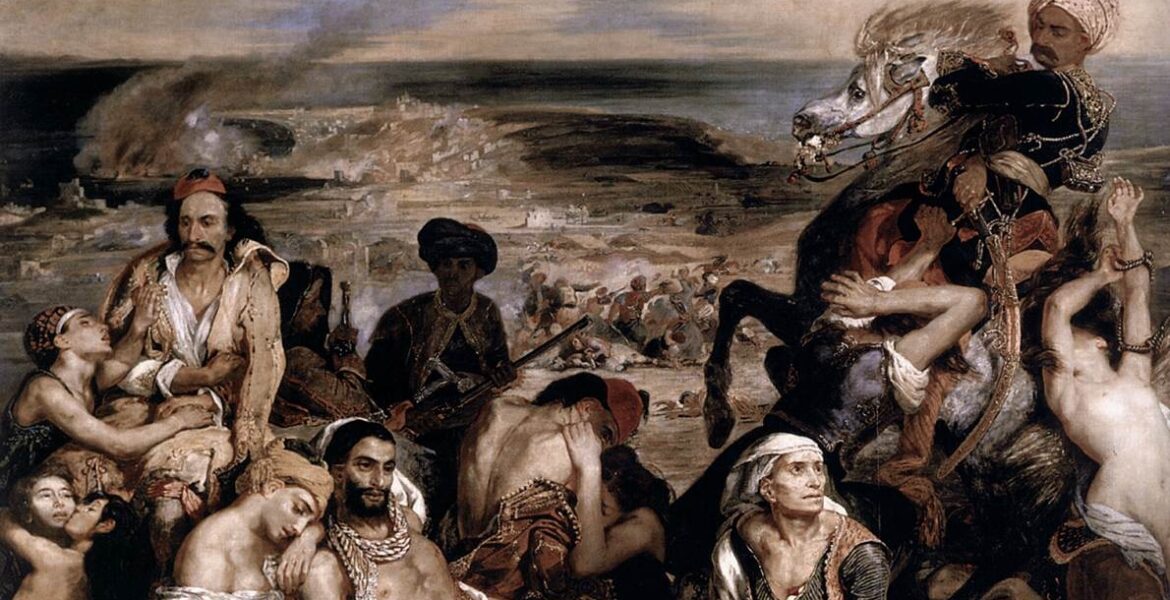On this day, 4 April 1821
On this day, 4 April 1821, Constantine Mourousis, Dimitrios Paparigopoulos and Antonios Tsouras were decapitated by the Ottomans in Constantinople.
There were numerous massacres during the Greek War of Independence (1821-1829) carried out by both the Ottoman forces and the Greek revolutionaries.
Massacres of Greeks took place especially in Ionia, Crete, Constantinople, Macedonia and the Aegean islands. 
Eugène Delacroix's Massacre of ChiosMost of the Greeks in the Greek quarter of Constantinople were massacred.
On Easter Sunday, 9 April 1821, Gregory V, the Ecumenical Patriarch (Archbishop) of Constantinople was hanged in the central outside portal of the Ecumenical Patriarchate by the Ottomans.
His body was mutilated and thrown into the sea, where it was rescued by Greek sailors.
One week later, the former Ecumenical Patriarch Cyril VI was hanged in the gate of the Adrianople's cathedral.
This was followed by the execution of two Metropolitans and twelve Bishops by the Turkish authorities.
By the end of April, a number of prominent Greeks had been decapitated by Turkish forces in Constantinople, including Constantine Mourousis, Dimitrios Paparigopoulos, Antonios Tsouras and Levidis Tsalikis; the Phanariots Petros Tsigris, Dimitrios Skanavis and Manuel Hotzeris, while Georgios Mavrocordatos was hanged.
On the Sultan’s orders, the Metropolitans Gregorios of Derkon, Dorotheos of Adrianople, Ioannikios of Tyrnavos, Joseph of Thessaloniki, and the Phanariote Georgios Callimachi and Nikolaos Mourousis were decapitated in Constantinople in May.
The Greek Phanariots
Constantine Mourousis was of the prominent Mourousis (Greek: Μουρούζης) family that was first mentioned in the Empire of Trebizond – a monarchy of the Byzantine Empire that flourished during the 13th through 15th centuries.
They became one of the leading families of Greek Phanariots - members of prominent Greek families in Phanar (Φανάρι, modern Fener), the chief Greek quarter of Constantinople where the Ecumenical Patriarchate is located.

The Greek Phanariots traditionally occupied four important positions in the Ottoman Empire: Voivode of Moldavia, Voivode of Wallachia, Grand Dragoman, and Grand Dragoman of the Fleet.
Despite their cosmopolitanism and often-Western education, the Phanariots were intensely aware of their Hellenism; a fact evidenced by Nicholas Mavrocordatos, author of the first Greek novel, ‘Philotheou Parerga’ (The Leisures of Philotheos) who stated, "We are a race completely Hellenic".
The Greek Phanariots emerged as a class of wealthy Greek merchants (of mostly noble Byzantine descent) during the second half of the 16th century, and were influential in the administration of the Ottoman Empire's Balkan domains in the 18th century.

Members of Phanariot families had acquired great wealth and influence during the 17th century and occupied high political and administrative posts in the Ottoman Empire.
From 1669 until the Greek War of Independence in 1821, Phanariots made up the majority of the dragomans to the Ottoman government (the Porte) and foreign embassies due to the Greeks' higher level of education than the general Ottoman population.
Along with the church dignitaries, local notables from the provinces and the large Greek merchant class, Phanariots represented the better-educated members of Greek society during Ottoman rule until the 1821 start of the Greek War of Independence.
During the war, Phanariots influenced decisions by the Greek National Assembly (the representative body of Greek revolutionaries, which met six times between 1821 and 1829).
Between 1711–1716 and 1821, a number of Phanariots were appointed Hospodars (princes) in the Danubian Principalities (Moldavia and Wallachia) - usually as a promotion from the offices of Dragoman of the Fleet and Dragoman of the Porte).
This period is known as the Phanariot epoch in Romanian history.
As a result of Phanariot and ecclesiastical administration, the Greeks expanded their influence in the 18th-century empire while retaining their Greek Orthodox faith and Hellenism.
The wealth of the extensive Greek merchant class provided the material basis for the intellectual revival featured in Greek life for more than half a century before 1821. Greek merchants endowed libraries and schools.
On the eve of the Greek War of Independence, the three most important centres of Greek learning were in the commercial centres of Chios, Smyrna and Aivali
Before the outbreak of the Greek War of Independence, the Phanariots were firmly established as the political elite of Hellenism.
According to Greek historian Constantine Paparrigopoulos, this was a natural evolution given the education of the Phanriots and their experience in supervising large parts of the empire.


